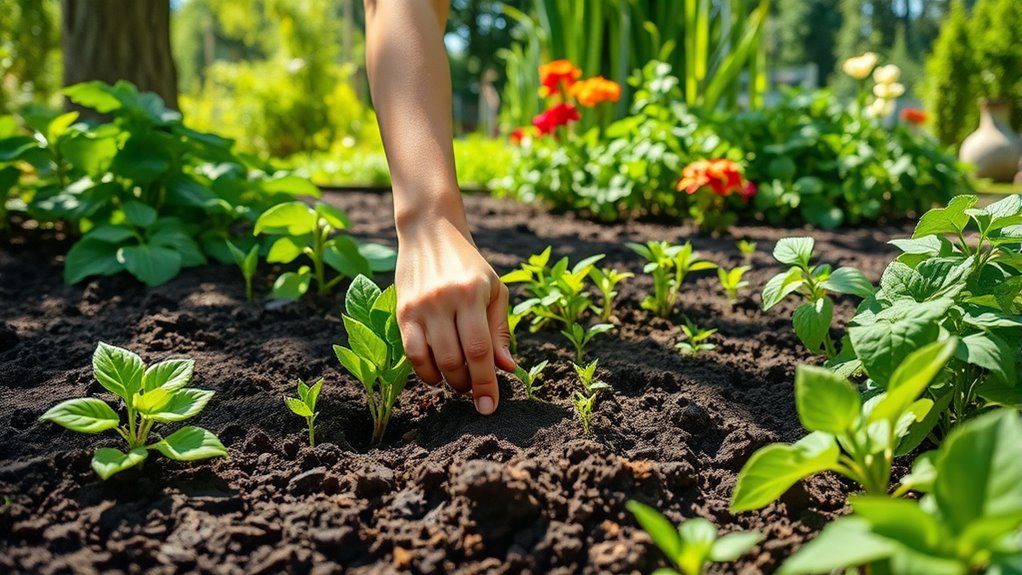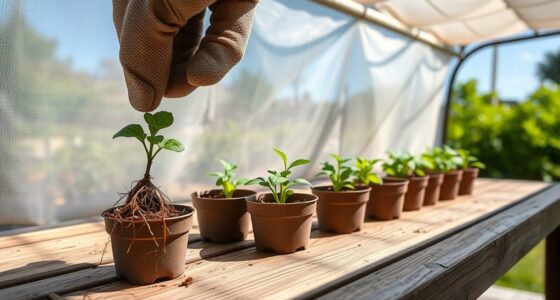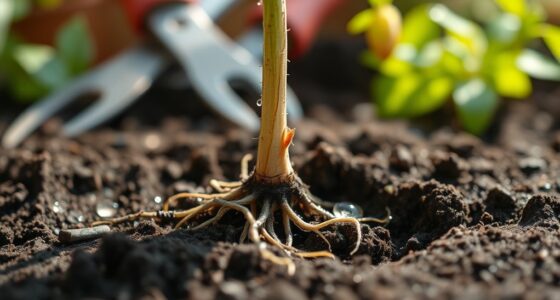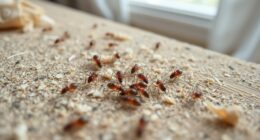Planting cover crops in your home garden is a smart way to boost soil health, suppress weeds, and manage pests naturally. You can sow them during the off-season or between main crops, then cut and incorporate them into the soil to improve fertility and structure. Using cover crops also attracts beneficial insects, reducing pest problems. If you want to explore practical tips and detailed benefits, keep going for more helpful insights.
Key Takeaways
- Select suitable cover crops based on your garden goals, such as nitrogen fixation or weed suppression.
- Sow cover crops during off-season or between main crops, adjusting timing to your garden’s schedule.
- Incorporate mature cover crops into soil through cutting or mulching to enrich nutrients naturally.
- Use cover crops as mulch to suppress weeds and attract beneficial insects for pest management.
- Rotate cover crops annually to maintain soil health and prevent pest and disease buildup.

Have you ever considered how cover crops can transform your home garden? These plants can do wonders beyond just adding greenery—they notably enhance your soil’s health and help manage pests naturally. When you plant cover crops, you’re actively improving soil fertility, which is the foundation for thriving vegetables and flowers. Cover crops like clover, vetch, or winter rye fix nitrogen from the air and deposit it into the soil, reducing the need for chemical fertilizers. As they grow, their roots break up compacted soil, allowing better water infiltration and root penetration for your main crops. This means healthier plants and higher yields with less effort and fewer inputs. Furthermore, when you turn these cover crops into the soil, they decompose into organic matter, enriching the soil’s structure and nutrient content over time. This continuous improvement creates a nourishing environment for your garden’s plants, making them more resilient and productive.
In addition to boosting soil fertility, cover crops are excellent for pest management. They act as natural barriers, helping to prevent pests from reaching your valuable plants. For example, planting aromatic cover crops like mustard or basil can repel certain insects, while dense cover crops like buckwheat can smother weed growth and reduce pest habitats. Cover crops also attract beneficial insects, such as ladybugs and predatory wasps, which prey on harmful pests. This natural pest control reduces your reliance on chemical pesticides, making your garden safer for pollinators and your family. Furthermore, cover crops can interrupt pest life cycles by breaking up the habitat where pests thrive, effectively reducing infestations over time. Their presence encourages a balanced ecosystem within your garden, where beneficial insects and soil microbes work together to keep pests in check.
Planting cover crops in your home garden is straightforward and adaptable. You can sow them during the off-season or in between main crops, depending on your planting schedule. When the cover crops mature, you cut them back and incorporate them into the soil or leave them as mulch. This practice enriches your soil naturally and helps maintain a healthy, pest-resistant environment. By choosing the right cover crops for your specific garden conditions, you set the stage for a more sustainable, productive garden that minimizes chemical use and maximizes natural health. Overall, incorporating cover crops is a smart, eco-friendly strategy that benefits your soil and keeps pests at bay, ensuring your garden thrives season after season.
Frequently Asked Questions
When Is the Best Time to Plant Cover Crops in My Garden?
You should plant cover crops during seasonal planting times, typically in early spring or late summer, depending on your climate. Make sure to prepare your soil beforehand by clearing weeds and loosening the soil. This gives the cover crops a strong start, enriching your soil and preventing erosion. Timing is key; planting when the soil is workable guarantees your cover crops grow healthy and provide maximum benefits for your garden.
Can Cover Crops Be Grown Alongside Existing Vegetables?
Think of your garden as a bustling symphony, where cover crops and vegetables play in harmony. Yes, you can grow cover crops alongside your vegetables through intercropping benefits, which improve soil health and suppress weeds. Choose cover crop varieties like clover or vetch that won’t compete for space or nutrients. This teamwork boosts productivity, enriches your soil, and keeps your garden thriving all season long.
How Do I Prevent Pests Attracted by Cover Crops?
To prevent pests attracted by cover crops, you should implement pest deterrent strategies like selecting pest-resistant cover crop varieties and rotating crops each season. Keep your garden clean by removing debris and weeds that harbor pests. Encourage beneficial insects that prey on pests and use organic barriers or traps when necessary. Effective cover crop pest management involves monitoring regularly and maintaining plant health, reducing the likelihood of pest problems.
Are There Specific Cover Crops for Shade Gardens?
You can choose shade-loving plants like clover, sweet alyssum, or hairy vetch for your shade garden. These low light cover crops thrive in partial to full shade, enriching your soil while minimizing competition with your main plants. By selecting these low light cover crops, you protect your garden’s health, add beauty, and create a lush, thriving environment. Embrace shade-friendly options to transform your garden into a vibrant oasis.
How Do I Remove Cover Crops Without Damaging Soil?
To remove cover crops without damaging your soil, start by cutting them down at the base. You can then compost the cuttings, which recycles nutrients back into the soil. Alternatively, use cover crop mulching by chopping and leaving the plant material on the soil surface to decompose naturally. This method protects your soil, prevents erosion, and enriches it, making your garden healthier and ready for new planting.
Conclusion
Think of cover crops like a safety net for your garden—it catches and restores nutrients, keeps weeds at bay, and protects your soil. When I first started planting them, I watched my garden bounce back stronger each season, much like a well-tended backyard trampoline. Just as a small investment in a cover crop can yield a bountiful harvest, caring for your soil now sets the stage for future growth. Embrace cover crops and watch your garden thrive.









